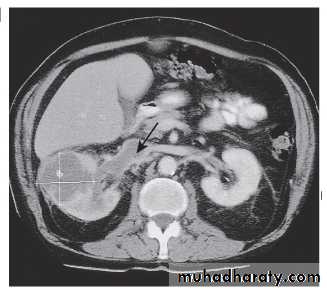بسم الله الرحمن الرحيم
RENAL ADENOCARCINOMA
Lecture by:
Dr. Zaidan Jayed Zaidan
RENAL ADENOCARCINOMA
This is by far the most common malignant tumour of the kidney in adults, with a prevalence of 16 cases per 100 000 population. It is twice as common in males as in females. The peak incidence is between 65 and 75 years of age and it is uncommon before 40. The tumour arises from renal tubules. Haemorrhage and necrosis give the cut surface a characteristic mixed golden-yellow and red appearance .Microscopically, 'clear cell' carcinomas are more common than 'granular cell' tumours. There is early spread of the tumour into the renal pelvis, causing haematuria, and along the renal vein, often extending into the inferior vena cava. Direct invasion of perinephric tissues is common. Lymphatic spread occurs to para-aortic nodes, while blood-borne metastases (which may be solitary) may develop almost anywhere in the body.
Clinical features
About 60% of cases present with haematuria, 40% with loin pain and only 25% with a mass. The triad of pain, haematuria and a mass is an important but late feature occurring in only 15% of cases. A remarkable range of systemic effects may be present, including fever, raised ESR, polycythaemia, disorders of coagulation, and abnormalities of plasma proteins and liver function tests. The patient may present with pyrexia of unknown origin or, rarely, with neuropathy.
Clinical features
Systemic effects may be due to tumour secretion of products such as renin, erythropoietin, parathyroid hormone-related peptide and gonadotrophins. The effects disappear when the tumour is removed but may reappear when metastases develop, and so can be used as markers of tumour activity.Investigations
The initial investigation is ultrasound, which allows differentiation between solid tumour and simple renal cysts. Thereafter, a contrast-enhanced CT of the abdomen and chest should be performed for staging .Management and prognosis
Radical nephrectomy that includes the perirenal fascial envelope and ipsilateral para-aortic lymph nodes is performed whenever possible. Renal adenocarcinoma is resistant to radiotherapy and chemotherapy but some benefit has been seen with immunotherapy using interferon and interleukin-2. Even when metastases are present, nephrectomy should always be considered; not only may systemic effects disappear, but there may even be regression of any metastases. Solitary metastases tend to remain single for long periods and excision is often worth while.If the tumour is confined to the kidney, 5-year survival is 75%. This falls to only 5% when there are distant metastases.


